|
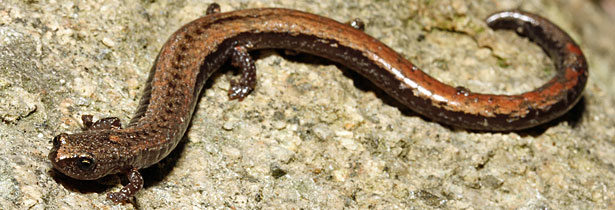 |
| Adult, Kern County |
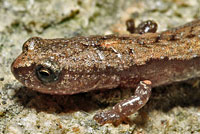 |
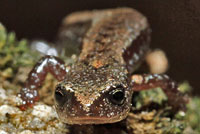 |
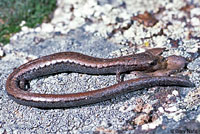 |
| Adult, Kern County |
Adult, Kern County |
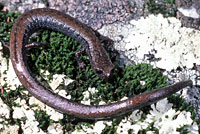 |
 |
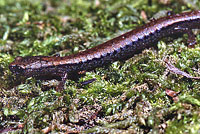 |
| Adult, Kern County |
Adult, Kern County |
Adult, Kern County |
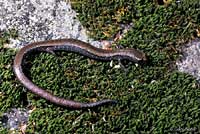 |
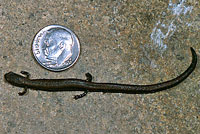 |
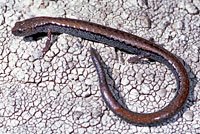 |
| Adult, Kern County |
Adult, Kern County |
Adult, Kern County |
 |
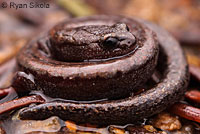 |
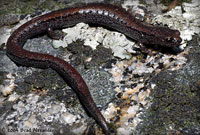 |
| Underside of adult, Kern County |
Adult, Tulare County © Ryan Sikola |
Adult, Kern County
© Brad Alexander |
 |
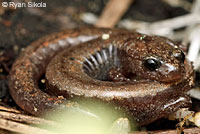 |
 |
| Adults, Tulare County © Ryan Sikola |
Adult, Tulare County © Ryan Sikola |
Comparison of parapatric B. altasierrae (bottom) and B. gregarius (top). Note the larger, more robust body and limbs on
B. altasierrae. © Brad Alexander |
| |
|
|
| Tail Loss |
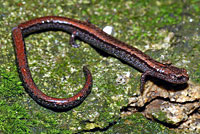 |
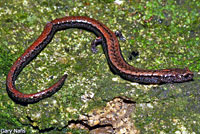 |
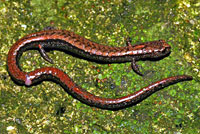 |
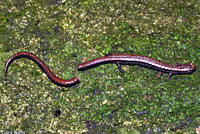 |
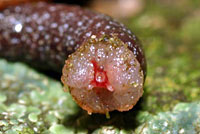 |
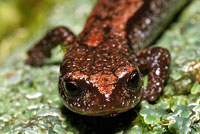 |
When a salamander is feeling threatened, it will sometimes drop its tail. This is referred to as caudal autotomy. Once removed from the body, the tail will wiggle frantically for several minutes, distracting a predator long enough for the salamander to crawl away slowly, or to remain still enough that it is no longer visible to the enemy.
In the first four pictures of the series above, an adult Greenhorn Mountains Slender Salamander in Kern County was photographed as it was writhing about, shaking its tail rapidly, until it finally broke off and continued wiggling on its own. The end of the detached tail is also shown above.
This tail detachment does not harm the salamander. It will survive and grow a new tail, but the salamander is at a disadvantage since it has lost an important defense mechanism, as well as energy stored in the tail, and any perceived size advantage it may have had in protecting its territory or attracting a mate.
Always handle salamanders (and lizards) carefully and avoid stressing an animal unnecessarily to prevent the tail from breaking off. |
| |
| Habitat |
 |
 |
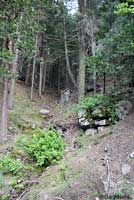 |
| Habitat, small trickle in evergreen forest, 5,900 ft., Kern County |
Habitat, 5,900 ft., Greenhorn
Mountains, Kern County |
Habitat, 5,900 ft., Greenhorn
Mountains, Kern County |
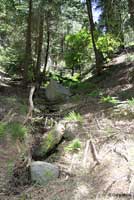 |
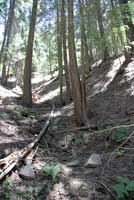 |
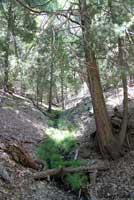 |
Habitat, 5,900 ft., Greenhorn
Mountains, Kern County |
Habitat, 5,900 ft., Greenhorn
Mountains, Kern County |
Habitat, 5,600 ft., Greenhorn
Mountains, Kern County |
| |
|
|
| Short Video |
| |
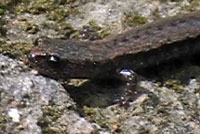 |
|
| |
A Greenhorn Mountains Slender Salamander and its habitat in the Greenhorn Mountains. |
|
|
|
|
| Description |
| |
| Size |
Adults are 1 3/8 - 1 7/8 inches long (3.5 - 4.7 cm) from snout to vent.
|
| Appearance |
A small slim salamander with 16-20 costal grooves.
Short limbs, a narrow head, long slender body, very long tail, and conspicuous costal and caudal grooves give this species the worm-like appearance typical of most Slender Salamanders.
There are four toes on the front and hind feet, which is also typical of Slender Salamanders.
(Other California salamanders have five toes on the hind feet.) |
| Color and Pattern |
Color is blackish brown with a reddish, yellowish, or dark brown dorsal stripe which is often not visible in large animals.
|
| Life History and Behavior |
A member of family Plethodontidae, the Plethodontid or Lungless Salamanders.
Plethodontid salamanders do not breathe through lungs. They conduct respiration through their skin and the tissues lining their mouth. This requires them to live in damp environments on land and to move about on the ground only during times of high humidity. (Plethodontid salamanders native to California do not inhabit streams or bodies of water but they are capable of surviving for a short time if they fall into water.)
Plethodontid salamanders are also distinguished by their nasolabial grooves, which are vertical slits between the nostrils and upper lip that are lined with glands associated with chemoreception.
All Plethodontid Salamanders native to California lay eggs in moist places on land.
The young develop in the egg and hatch directly into a tiny terrestrial salamander with the same body form as an adult.
(They do not hatch in the water and begin their lives as tiny swimming larvae breathing through gills like some other types of salamanders.)
|
| Activity |
Little is known about this species.
Most Slender Salamander species are active on rainy or wet nights when temperatures are moderate, fall through spring, retreating underground when the soil dries or when air temperature drops to near freezing.
At higher elevations, activity may be restricted to spring and early summer and early fall.
Found under rocks, logs, bark, and other surface debris, including large pine cones.
This species is usually associated with seepages and springs and appears to prefer very wet conditions. |
| Defense |
Slender salamanders use several defense tactics, including:
- Coiling and remaining still, relying on cryptic coloring to avoid detection.
- Uncoiling quickly and springing away repeatedly bouncing over the ground, then remaining still again to avoid detection.
- Detaching the tail, which wriggles on the ground to distract a predator from the salamander long enough for it to escape.
(After its tail is detached or severed, the salamander will grow a new tail.) |
| Diet and Feeding |
Most likely eats a variety of small invertebrates.
Feeding behavior is not well known, but other Batrachoseps species are sit-and-wait predators that use a projectile tongue to catch prey. |
| Reproduction |
Little is known about the breeding behavior of this species.
Reproduction is terrestrial.
Breeding and egg-laying probably occurs during the rainy period from November to January. |
| Eggs |
| All species of Slender Salamanders lay eggs, typically in moist places on land. |
| Young |
Young hatch fully formed.
|
| Habitat |
Occurs in heavily forested areas of mixed conifers and deciduous oaks.
Associated with seepages and springs which remain moist through the summer.
|
| Geographical Range |
Endemic to California.
B. altasierrae is the common high elevation Batrachoseps species found on the western slopes of the southern Sierra Nevada.
Occurs in the Greenhorn Mountains north to the Tule River and Kern River highland drainages.
It is also known from one area on the western edge of the Kern Plateau east of the Kern River. |
| Elevational Range |
Occurs from 3,900 - 8,200 ft. (1200 - 2500 m) in elevation.
|
| Notes on Taxonomy |
B. altasierrae was described in February 2012 by Jockusch et al *. They re-named the salamanders once known as
B. relictus found north of the Kern River, and assigned salamanders south of the river and on Breckenridge Mountain the name B. relictus.
B. relictus was described in 1968, then reduced to a subspecies of B. pacificus in 1980. The species name was reinstated with the description of several new species of Batrachoseps in the Sierra Nevada by Jockush, Wake, and Janev in 1998.
B. pacificus relictus was partitioned into four species - B. diabolicus, B. regius, B. kawia and B. relictus.
The 1968 description referred to compound group of animals from a wide range in the Sierras, which includes several of the new animals described in 1998. But since no specimens from the 1968 type locality in the lower Kern River Canyon have been found since 1971, the authors of the 1998 paper described animals from the north and west sides of the Kern River.
Here's a Diagram of the Batrachoseps Complex showing the relationships between species.
Alternate and Previous Names (Synonyms)
Batrachoseps relictus - Relictual Slender Salamander (Stebbins 2003, 2012)
Batrachoseps pacificus - Pacific Slender Salamander (Stebbins 1985)
Batrachoseps attenuatus - California Slender Salamander (Stebbins 1954, 1966)
Batrachoseps attenuatus attenuatus - Worm-salamander (Bishop 1943)
Batrachoseps attenuatus - Slender Salamander (Storer 1925)
Batrachoseps nigriventris (Cope 1869)
Batrachoseps attenuatus (Cooper 1868)
Batrachoseps attenuata (Baird 1850)
Salamandrina attenuata (Eschscholtz 1833)
|
| Conservation Issues (Conservation Status) |
| None |
|
| Taxonomy |
| Family |
Plethodontidae |
Lungless Salamanders |
Gray, 1850 |
| Genus |
Batrachoseps |
Slender Salamanders |
Bonaparte, 1841 |
Species
|
altasierrae |
Greenhorn Mountains Slender Salamander |
Jockush, Martinez-Solano, Hansen, and Wake, 2012 |
|
Original Description |
Jokusch et al., 2012, Zootaxa 3190: 1-30.
Brame and Murray, 1968 - B. relictus (part) - Sci. Bull. Nat. Hist. Mus. Los Angeles Co., No. 4, p. 5.
from Original Description Citations for the Reptiles and Amphibians of North America © Ellin Beltz
|
|
Meaning of the Scientific Name |
Batrachoseps - Greek - batrachos = amphibian, frog + seps = lizard — describes lizard-like appearance
altasierrae - named after the type locality: Alta Sierra
from Scientific and Common Names of the Reptiles and Amphibians of North America - Explained © Ellin Beltz
|
|
Similar Neighboring Salamanders |
Batrachoseps kawia
Batrachoseps regius
Batrachoseps robustus
Batrachoseps simatus
Batrachoseps gregarious
Batrachoseps bramei
Batrachoseps relictus
Batrachoseps stebbensi
|
|
More Information and References |
* Jokusch, Elizabeth L., Inigo Martinez-Solano, Robert W. Hansen, & David B. Wake.
Morphological and molecular diversification of slender salamanders (Caudata: Plethodontidae: Batrachoseps) in the southern Sierra Nevada of California with descriptions of two new species.
©2012 - Magnolia Press Zootaxa 3190: 1-30 (2012) www.mapress.com/zootaxa/
AmphibiaWeb
Salamander Diversity in the Kern Valley Region
Hansen, Robert W. Kern River Research Area Field Notes Spring 1997 Vol. 6, No. 2
Jockusch, E. L., D. B. Wake, and K. P. Yanev. "New species of slender salamanders, Batrachoseps (Amphibia: Plethodontidae), from the Sierra Nevada of California." Contributions in Science, Natural History Museum of Los Angeles County, #472 1998. Hansen, Robert W. and Shedd, Jackson D. California Amphibians and Reptiles. (Princeton Field Guides.) Princeton University Press, 2025.
Stebbins, Robert C., and McGinnis, Samuel M. Field Guide to Amphibians and Reptiles of California: Revised Edition (California Natural History Guides) University of California Press, 2012.
Stebbins, Robert C. California Amphibians and Reptiles. The University of California Press, 1972.
Flaxington, William C. Amphibians and Reptiles of California: Field Observations, Distribution, and Natural History. Fieldnotes Press, Anaheim, California, 2021.
Nicholson, K. E. (ed.). 2025. Scientific and Standard English Names of Amphibians and Reptiles of North America North of Mexico, with Comments Regarding Confidence in Our Understanding. Ninth Edition. Society for the Study of Amphibians and Reptiles. [SSAR] 87pp.
Samuel M. McGinnis and Robert C. Stebbins. Peterson Field Guide to Western Reptiles & Amphibians. 4th Edition. Houghton Mifflin Harcourt Publishing Company, 2018.
Stebbins, Robert C. A Field Guide to Western Reptiles and Amphibians. 3rd Edition. Houghton Mifflin Company, 2003.
Behler, John L., and F. Wayne King. The Audubon Society Field Guide to North American Reptiles and Amphibians. Alfred A. Knopf, 1992.
Robert Powell, Roger Conant, and Joseph T. Collins. Peterson Field Guide to Reptiles and Amphibians of Eastern and Central North America. Fourth Edition. Houghton Mifflin Harcourt, 2016.
Powell, Robert., Joseph T. Collins, and Errol D. Hooper Jr. A Key to Amphibians and Reptiles of the Continental United States and Canada. The University Press of Kansas, 1998.
American Museum of Natural History - Amphibian Species of the World 6.2
Bartlett, R. D. & Patricia P. Bartlett. Guide and Reference to the Amphibians of Western North America (North of Mexico) and Hawaii. University Press of Florida, 2009.
Bishop, Sherman C. Handbook of Salamanders. Cornell University Press, 1943.
Lannoo, Michael (Editor). Amphibian Declines: The Conservation Status of United States Species. University of California Press, June 2005.
Petranka, James W. Salamanders of the United States and Canada. Smithsonian Institution, 1998.
|
|
|
The following conservation status listings for this animal are taken from the July 2025 State of California Special Animals List and the July 2025 Federally Listed Endangered and Threatened Animals of California list (unless indicated otherwise below.) Both lists are produced by multiple agencies every year, and sometimes more than once per year, so the conservation status listing information found below might not be from the most recent lists, but they don't change a great deal from year to year.. To make sure you are seeing the most recent listings, go to this California Department of Fish and Wildlife web page where you can search for and download both lists:
https://www.wildlife.ca.gov/Data/CNDDB/Plants-and-Animals.
A detailed explanation of the meaning of the status listing symbols can be found at the beginning of the two lists. For quick reference, I have included them on my Special Status Information page.
If no status is listed here, the animal is not included on either list. This most likely indicates that there are no serious conservation concerns for the animal. To find out more about an animal's status you can also go to the NatureServe and IUCN websites to check their rankings.
Check the current California Department of Fish and Wildlife sport fishing regulations to find out if this animal can be legally pursued and handled or collected with possession of a current fishing license. You can also look at the summary of the sport fishing regulations as they apply only to reptiles and amphibians that has been made for this website.
|
| Organization |
Status Listing |
Notes |
| NatureServe Global Ranking |
G2 |
Imperiled |
| NatureServe State Ranking |
S2 |
Imperiled |
| U.S. Endangered Species Act (ESA) |
None |
|
| California Endangered Species Act (CESA) |
None |
|
| California Department of Fish and Wildlife |
None |
|
| Bureau of Land Management |
None |
|
| USDA Forest Service |
None |
|
| IUCN |
None |
|
|
|
|































